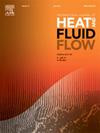IF 2.6
3区 工程技术
Q2 ENGINEERING, MECHANICAL
International Journal of Heat and Fluid Flow
Pub Date : 2025-04-11
DOI:10.1016/j.ijheatfluidflow.2025.109837
引用次数: 0
摘要
水下航行时的壁面摩擦阻力会降低推进效率,并产生大量噪音。虽然受仿生学原理启发提出了几种减少阻力的方法,但它们往往无法长期维持较高的阻力减少效果。在本研究中,我们对传统的矩形凹槽进行了优化,并设计了两种新的凹槽结构,在其下方设置了粘液分泌孔。各种减阻剂的流变学实验表明,仿生粘液遵循 Carreau 模型,模拟确定了最有效的减阻粘液。为研究减阻沟槽和仿生粘液的协同效应,建立了一个流体力学模型,并利用大涡流模拟对其进行求解和分析。结果表明,当弯曲凹槽中的粘液分泌速度为 0.25 米/秒时,阻力降低率最高(37.5%)。利用涡流动力学理论,我们提出了一个将阻力降低率与涡流体积相关联的函数,用于定量分析。理论计算结果表明,阻力减少率与粘液分泌速度呈正相关,与模拟结果一致。我们的结论是,阻力减小机制涉及微沟槽和粘液的结合,微沟槽和粘液减少了壁附近涡旋结构的数量和密度,减缓了涡旋结构的演化,减弱了湍流强度,从而导致阻力减小。通过将模拟和理论相结合,该研究为理论减阻计算提供了参考,并为设计减阻表面提出了新的见解。本文章由计算机程序翻译,如有差异,请以英文原文为准。
Simulation and mechanism of the synergistic drag reduction performance of two types of microgroove surfaces and mucus
Wall friction resistance during underwater travel reduces propulsion efficiency and generates significant noise. While several drag reduction methods inspired by bionic principles have been proposed, they often fail to sustain high drag reduction over time. In this study, we optimize conventional rectangular grooves and design two new groove structures, with mucus secretion pores positioned below them. Rheological experiments on various drag-reducing agents reveal that the bionic mucus follows the Carreau model, and simulations identify the most effective mucus for drag reduction. A hydrodynamic model is developed to examine the synergistic effect of the drag-reducing grooves and bionic mucus, which is solved using large vortex simulations and analyzed accordingly. The results indicate that the highest drag reduction rate (37.5 %) is achieved when the mucus secretion velocity is 0.25 m/s in the curved groove. Using vortex dynamics theory, we propose a function that relates drag reduction rate to vortex volume for quantitative analysis. The theoretical calculations show a positive correlation between drag reduction and mucus secretion speed, consistent with the simulation results. We conclude that the drag reduction mechanism involves the combination of microgrooves and mucus, which reduces the number and density of vortex structures near the wall, slows their evolution, and weakens turbulence intensity, leading to drag reduction. By integrating simulation and theory, this study offers a reference for theoretical drag reduction calculations and presents new insights for designing drag-reducing surfaces.
求助全文
通过发布文献求助,成功后即可免费获取论文全文。
去求助
来源期刊

International Journal of Heat and Fluid Flow
工程技术-工程:机械
CiteScore
5.00
自引率
7.70%
发文量
131
审稿时长
33 days
期刊介绍:
The International Journal of Heat and Fluid Flow welcomes high-quality original contributions on experimental, computational, and physical aspects of convective heat transfer and fluid dynamics relevant to engineering or the environment, including multiphase and microscale flows.
Papers reporting the application of these disciplines to design and development, with emphasis on new technological fields, are also welcomed. Some of these new fields include microscale electronic and mechanical systems; medical and biological systems; and thermal and flow control in both the internal and external environment.
 求助内容:
求助内容: 应助结果提醒方式:
应助结果提醒方式:


